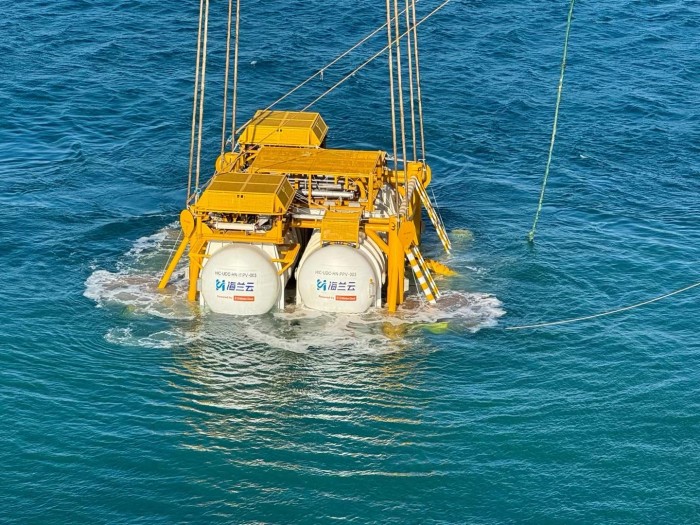First Phase of Commercial Subsea Data Center Completed

A set of data pods are lowered into the sea in Hainan. (COURTESY PHOTO)
By Wang Zhuhua & ZHONG Jianli
In the azure waters off the coast of Lingshui in south China's Hainan province, a milestone of technological innovation has been achieved after a 1300-tonne data pod was lowered to its designated position under the sea.
As the core equipment of Hainan's demonstrative Underwater Data Center (UDC) project, the pod successfully docked with its base and completed necessary tests, marking the completion of the first phase of the world's first commercial UDC project.
Pu Ding, general manager of the project said data centers are fundamental to the storing, computing and processing of information, and are the backbone of Internet services.
"The UDC represents a new, eco-friendly, and low-carbon data center system. By placing IT infrastructure such as servers within pressure vessels on the seabed, the center utilizes gravity heat pipe technology, employing the flow of seawater for natural cooling of the data center equipment. This approach offers advantages such as green, low carbon, safe, reliable, and cost-efficient," said Pu.
In December 2022, the UDC project deployed its first two data pods, which will work in tandem with the newly deployed one to form the world's largest underwater data pod cluster.
According to Li Jiawen, vice president of Hailan Cloud, the technical provider of the project, these pods not only serve as data storage facilities, but also function as a supercomputer on the seabed. Packed with intelligent computing equipment, they can process over four million high-definition images in 30 seconds, equivalent to the workload of 60,000 traditional computers operating simultaneously.
The project is planned to be executed in three phases. The first phase includes the deployment of three sets of underwater data pods. Subsequent phases will witness the construction of 30 and 100 data pods respectively.
Comparing the undersea project with a land-based traditional data center of similar scale, Pu said, "Once the entire project is completed, it is projected to save 122 million kWh of electricity, reduce the land area needed by 68,000 square meters, and conserve 105,000 tons of freshwater annually."
He added that through comprehensive design and development of marine infrastructure, the underwater data center, when combined with offshore renewable energy, marine monitoring and ocean farming, can promote the intensive utilization of marine resources, facilitating the synergistic development of the digital economy and marine economy.
The exploration of UDCs initially began with Microsoft in 2015. After three sea trials and retrievals, Microsoft's experiments confirmed that servers operating in a sealed and inert gas environment on the seabed exhibited eight times more reliability than those in land-based data centers.
"The Hainan project team, after innovating current international advanced technologies, not only fills the gap in China's development of marine engineering and data center infrastructure, but also positions its overall technology and industrial capabilities at the forefront internationally," said Li.







